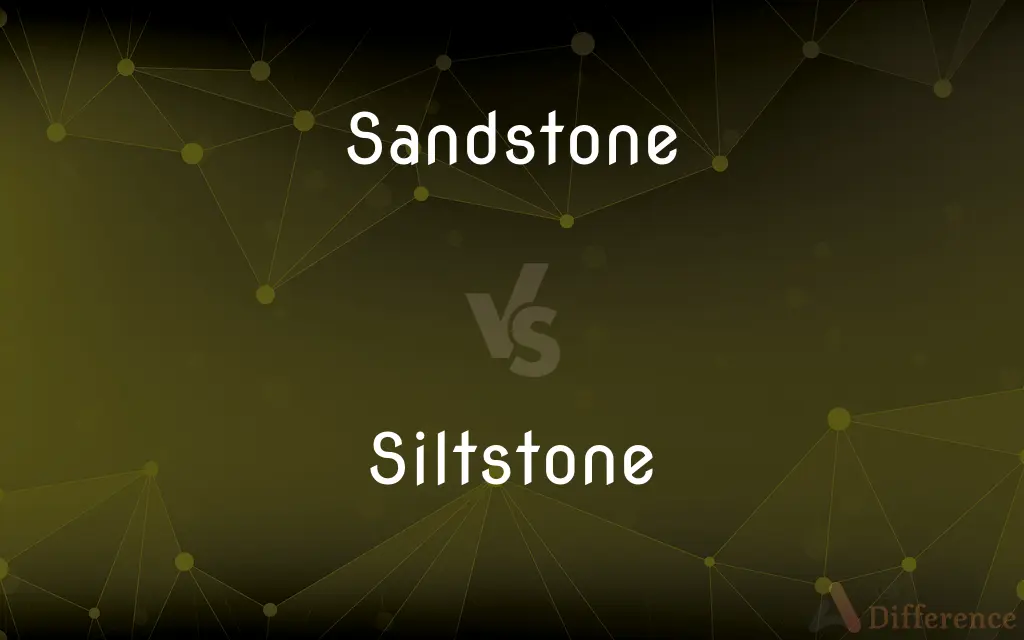Sandstone vs. Siltstone — What's the Difference?
By Maham Liaqat & Urooj Arif — Updated on March 22, 2024
Sandstone is a coarser, more porous rock, while siltstone is finer-grained and denser.

Difference Between Sandstone and Siltstone
Table of Contents
ADVERTISEMENT
Key Differences
Sandstone is a sedimentary rock composed mainly of sand-sized mineral particles or rock fragments. On the other hand, siltstone is made up of silt-sized particles, smaller than sand and larger than clay.
The main difference between sandstone and siltstone lies in their grain size and porosity. Sandstone, with its larger grain sizes, tends to be more porous and has a rougher texture. This porosity makes sandstone a reservoir for oil and natural gas. Siltstone, with its finer grains, feels smoother and is more compact, reflecting its lower porosity and finer texture.
Both rocks are indicative of the environments in which they were formed. Sandstone suggests more energetic environments where water or wind was able to transport and deposit sand-sized particles. In contrast, siltstone indicates quieter aquatic environments where finer particles settled from suspension.
In terms of uses, sandstone's porosity and strength make it a popular building material, especially for decorative elements and paving. Siltstone, being finer-grained and denser, is less commonly used as a building material but has applications in some sedimentary rock projects where its smooth texture and uniform appearance are desired.
Comparison Chart
Grain Size
Sand-sized particles
Silt-sized particles
ADVERTISEMENT
Porosity
Higher, due to larger grain size
Lower, due to finer grain size
Texture
Rougher
Smoother
Formation
In energetic environments like rivers and beaches
In calmer aquatic environments
Common Uses
Building material, especially for exteriors and paving
Less commonly used, suitable for specific rock projects
Compare with Definitions
Sandstone
A rock that can serve as a reservoir for oil and gas.
The oil company is exploring the sandstone formation for potential drilling.
Siltstone
A fine-grained sedimentary rock.
The siltstone layer was smooth to the touch, indicating its fine grain size.
Sandstone
A material often used in construction due to its durability.
The ancient city's buildings were primarily made of sandstone.
Siltstone
Formed in calm aquatic environments.
This siltstone likely formed at the bottom of a slow-moving river.
Sandstone
Characterized by a wide range of colors, from red to gray.
The sandstone formations at the park display a beautiful array of colors at sunset.
Siltstone
Reflects quieter depositional settings.
The fine layers in the siltstone indicate a period of calm water deposition.
Sandstone
Indicates an energetic depositional environment.
The presence of cross-bedded sandstone suggests ancient river channels.
Siltstone
Less commonly used in construction.
Although durable, siltstone is not as popular as sandstone for building materials.
Sandstone
A sedimentary rock consisting of sand-sized grains.
The sandstone cliffs along the coast have been sculpted by the wind.
Siltstone
Denser and less porous than sandstone.
Siltstone's dense composition makes it less permeable to water.
Sandstone
Sandstone is a clastic sedimentary rock composed mainly of sand-sized (0.0625 to 2 mm) silicate grains. Sandstones comprise about 20–25% of all sedimentary rocks.Most sandstone is composed of quartz or feldspar (both silicates) because they are the most resistant minerals to weathering processes at the Earth's surface, as seen in the Goldich dissolution series.
Siltstone
Siltstone, also known as aleurolite, is a clastic sedimentary rock that is composed mostly of silt. It is a form of mudrock with a low clay mineral content, which can be distinguished from shale by its lack of fissility.Although its permeability and porosity is relatively low, siltstone is sometimes a tight gas reservoir rock, an unconventional reservoir for natural gas that requires hydraulic fracturing for economic gas production.Siltstone was prized in ancient Egypt for manufacturing statuary and cosmetic palettes.
Sandstone
A sedimentary rock formed by the consolidation and compaction of sand and held together by a natural cement, such as silica.
Siltstone
A fine-grained rock of consolidated silt.
Sandstone
A sedimentary rock produced by the consolidation and compaction of sand, cemented with clay etc.
Siltstone
A sedimentary rock whose composition is intermediate in grain size between the coarser sandstone and the finer mudstone.
Sandstone
A rock made of sand more or less firmly united. Common or siliceous sandstone consists mainly of quartz sand.
Siltstone
A fine-grained sandstone of consolidated silt
Sandstone
A sedimentary rock consisting of sand consolidated with some cement (clay or quartz etc.)
Common Curiosities
Where does sandstone typically form?
Sandstone forms in environments with significant water presence, like beaches and riverbeds, where sand-sized particles can accumulate.
How does siltstone's texture compare to that of sandstone?
Siltstone has a smoother texture than sandstone due to its finer grain size.
What is the main difference between sandstone and siltstone?
The main difference lies in their grain size; sandstone has sand-sized particles, while siltstone has silt-sized particles.
What are the typical uses of sandstone?
Sandstone is widely used in construction, especially for decorative elements, exteriors, and paving due to its durability and aesthetic appeal.
What does the presence of sandstone indicate about an environment's past?
It suggests a more energetic environment, like ancient rivers or shorelines, where sand-sized particles were deposited.
Are there specific conditions under which siltstone forms?
Yes, siltstone forms under quieter conditions in aquatic environments, where fine particles can slowly settle.
How does the formation process of sandstone and siltstone differ?
The process differs mainly in the energy of the environment, with sandstone forming under more energetic conditions than siltstone.
What kind of environment does siltstone formation indicate?
Siltstone formation indicates calmer aquatic environments where finer particles settled from suspension.
How does the grain size affect the rock's porosity?
Larger grain sizes, like in sandstone, result in higher porosity, allowing fluids to move through more easily.
Can siltstone be used as a building material?
While it's denser and less porous, making it durable, siltstone is less commonly used as a building material compared to sandstone.
What does the texture of siltstone tell us?
The smooth texture of siltstone indicates a finer grain size and a more compact formation.
Is siltstone or sandstone more porous?
Sandstone is more porous due to its larger grain size, making it a good reservoir for oil and gas.
Why is sandstone preferred over siltstone in construction?
Sandstone's porosity and range of colors make it a versatile and visually appealing choice for construction projects.
Can the color of sandstone vary?
Yes, sandstone can range in color from red to gray, depending on the minerals it contains.
Share Your Discovery

Previous Comparison
Amp vs. Imp
Next Comparison
Kinara vs. MenorahAuthor Spotlight
Written by
Maham LiaqatCo-written by
Urooj ArifUrooj is a skilled content writer at Ask Difference, known for her exceptional ability to simplify complex topics into engaging and informative content. With a passion for research and a flair for clear, concise writing, she consistently delivers articles that resonate with our diverse audience.














































